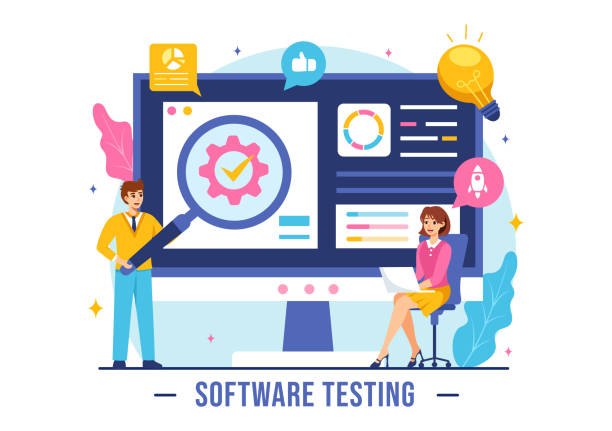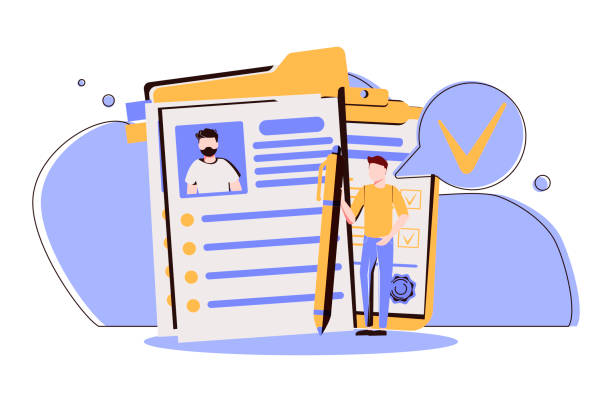The Unparalleled Importance of Secure Website Design in the Digital Age

In today’s world, where physical boundaries are fading and a large part of our daily activities has shifted to the virtual space, secure website design is not just a competitive advantage, but a vital necessity.
#WebSecurity #DataProtection #OnlineBusiness.
Users expect their personal and financial data to be kept in a completely secure environment, and any negligence in this regard can lead to loss of trust, irreparable financial damage, and even harm to a brand’s reputation.
In fact, security risks constantly lurk for websites; from phishing attacks and malicious code to complex cyber intrusions aimed at stealing sensitive information, sabotage, or ransomware.
For this reason, a specialized approach to website security must be considered from the very initial stages of design and development.
A secure website means reducing vulnerabilities, protecting user data, and maintaining system integrity.
This not only includes technical measures but also depends on the organization’s security culture and employee awareness.
Websites that are weak in terms of security are easily targeted by attackers, and the consequences can be extensive, including loss of customer data, leakage of confidential information, and service downtime.
These incidents not only cause direct financial losses but also inflict irreparable damage on the business’s reputation and credibility.
Therefore, investing in website security from the outset is the smartest decision a business can make.
Are you dissatisfied with the low conversion rate of visitors to customers on your e-commerce site?
Solve this problem forever with professional e-commerce website design by Rasawob!
✅ Increase visitor-to-customer conversion rate
✅ Create an excellent user experience and gain customer trust
⚡ Get free consultation
Familiarity with the Most Common Threats and Vulnerabilities in Websites

To achieve secure website design, we must first know our enemies.
#CyberThreats #WebVulnerability #Hacking.
Websites are constantly exposed to various cyberattacks, each seeking to infiltrate and exploit in a specific way.
Understanding these common threats and vulnerabilities is the first step in countering them and enhancing website security.
Among the most common attacks is SQL Injection, where an attacker attempts to inject malicious SQL code into website inputs to infiltrate the database and manipulate or steal information.
XSS (Cross-Site Scripting) attacks are another type of attack where malicious JavaScript code is injected into web pages and can steal user information or take control of their browsers.
Denial of Service (DoS) and Distributed Denial of Service (DDoS) attacks, by sending a massive volume of fake traffic to the server, cause the website to crash and prevent real users from accessing it.
Furthermore, security weaknesses in Session Management, incorrect server configurations, lack of software updates, and the use of weak passwords can all act as vulnerabilities.
In the analytical section, it is necessary that these threats be continuously identified and evaluated to adopt appropriate defensive measures.
Awareness of these vulnerabilities is essential for any developer or website administrator to design and implement effective strategies to protect their site against these attacks.
This understanding helps us to take a specialized approach to preventing intrusions.
Principles and Best Practices in Secure Coding and Web Development

One of the main pillars of secure website design is adhering to secure coding principles.
#SecureCoding #SecureDevelopment #OWASP.
From the very beginning of the project, a security-first approach must be adopted, and all developers must adhere to these principles.
This section provides a comprehensive guide for implementing best practices in the development process.
For example, one of the most important recommendations is to use secure frameworks and libraries that are regularly updated and have a good security track record.
Also, thorough Input Validation of user inputs is crucial to prevent attacks such as SQL Injection and XSS; every user input must be carefully checked and sanitized.
Encrypting sensitive data, especially personal and financial information, both in transit and at rest, is another fundamental principle.
Using strong hashing functions to store passwords instead of storing them in clear text is essential.
Error handling and logging should also be done in a way that sensitive information is not revealed in logs, and error messages do not provide too many details about the internal system structure that attackers could exploit.
The “Principle of Least Privilege” also states that every user or process should only have access to the minimum permissions necessary to perform its task.
For better education, a table of secure coding best practices is provided below, which can help developers write stronger and more secure code.
| Security Principle | Description | Importance |
|---|---|---|
| Input Validation | All user inputs must be checked and sanitized for format, type, and length to prevent code injection attacks. | Very High |
| Data Encryption | Sensitive information (passwords, credit card details) must be encrypted during storage and transmission. | Very High |
| Secure Session Management | Session tokens must be securely generated, stored, and managed to prevent session hijacking. | High |
| Error Handling and Logging | Error messages should not reveal internal system information, and logs should be used to detect attacks. | High |
| Least Privilege | Every user or process should only have access to the resources and permissions it needs. | Very High |
| Regular Updates | All software, frameworks, and libraries must be regularly updated to fix known vulnerabilities. | Very High |
The Role of HTTPS, SSL/TLS, and Security Certificates in a Secure Website

When it comes to secure website design, the first thing that comes to many users’ minds is the presence of the HTTPS protocol and the padlock symbol in the browser’s address bar.
#HTTPS #SSL_TLS #SecurityCertificate.
This protocol, which is the secure version of HTTP, plays a vital role in protecting data in transit between the user’s browser and the website server.
Using HTTPS means that the communication between the user and the server is encrypted, preventing eavesdropping, tampering, or forging of information by third parties.
This is especially important for websites that exchange sensitive information such as credit card details, passwords, or personal data.
HTTPS ensures security by using SSL/TLS (Secure Sockets Layer/Transport Layer Security) certificates.
An SSL/TLS certificate is a digital document that verifies the website’s identity and establishes an encrypted connection.
Without this certificate, browsers warn users that the website is not secure, and this can severely impact user trust and the website’s search engine ranking.
In the explanatory domain, it should be noted that even for simpler websites that do not exchange sensitive information, using HTTPS is recommended, as Google and other search engines give higher rankings to HTTPS-enabled websites.
This simple yet vital step is a big leap towards securing the website and reassuring users.
There are also different types of SSL certificates, from Domain Validation (DV) certificates to Organization Validation (OV) and Extended Validation (EV) certificates, each offering a different level of identity verification.
The choice of the appropriate certificate type depends on the type of website and the degree of sensitivity it has to user trust.
Did you know that 85% of customers check your company’s website before any interaction?
With Rasawob, build a corporate website that truly represents your credibility.
✅ Increase brand credibility and customer trust
✅ Attract high-quality leads
⚡ Get free website design consultation
Database Security and Protection Against SQL Injection Attacks

The database is the heart of every website, storing user information, products, transactions, and many other vital data.
Therefore, database security plays a key role in secure website design.
#DatabaseSecurity #SQL_Injection #DataProtection.
One of the most common and dangerous attacks on databases is the SQL Injection attack, which was mentioned earlier.
In this attack, attackers attempt to inject malicious SQL commands into the database by manipulating user inputs.
These attacks can lead to the theft, alteration, or even complete deletion of data.
To counter this threat, several specialized and educational strategies exist.
The most important method is the use of Prepared Statements and Parameterized Queries.
These methods ensure that user inputs are processed as data and not as part of the SQL command, thus preventing the execution of malicious code.
In addition, the principle of least privilege should be followed for database access; that is, users connecting to the database should only have access to the minimum permissions necessary to perform their tasks.
For example, a website user should not have permission to delete or alter the structure of database tables.
Encrypting sensitive data in the database, regular updates of database software, and the use of Database Firewalls are also important measures in web security.
Also, regular review of database logs can help detect intrusion attempts.
A comprehensive approach to database security is one of the main pillars of a secure website and can prevent major security disasters.
The Importance of User Authentication and Access Management

One of the most important pillars of secure website design is robust and reliable Authentication and Authorization systems.
#Authentication #AccessManagement #UserSecurity.
Without a powerful authentication system, attackers can easily infiltrate user accounts by guessing weak passwords or using stolen credentials.
Our guidance in this area includes using strong and complex passwords that are a combination of uppercase and lowercase letters, numbers, and symbols.
Encouraging users to use unique passwords for each site is also crucial.
Implementing Two-Factor Authentication (2FA) or Multi-Factor Authentication (MFA) is a big step towards increasing security.
This method provides an additional layer of security even if the password is compromised, making intrusion more difficult.
In addition to authentication, access management is also of particular importance.
The system must ensure that users only have access to the resources and functionalities they are authorized to use.
This means implementing access control models such as Role-Based Access Control (RBAC), where permissions are defined based on the user’s role in the system.
For example, a regular user should have much less access than a system administrator.
Monitoring user activities and identifying suspicious patterns can also help detect intrusions.
This specialized section requires careful design and cautious implementation to ensure both user security and a good user experience.
The Importance of Regular Updates and Penetration Testing

Another vital aspect in the process of secure website design is performing regular updates and periodic penetration tests.
#SecurityUpdates #PenetrationTesting #VulnerabilityScanning.
Software, frameworks, Content Management Systems (CMS), and plugins are constantly evolving, and new vulnerabilities are discovered in them.
Failure to update in a timely manner can expose your site to these known vulnerabilities and make it an easy target for attackers.
This informative and analytical section emphasizes the importance of continuous vigilance.
Many successful cyberattacks occur due to the use of outdated and unpatched software.
Therefore, a regular program for updating all website components, including the server operating system, web server, database, programming language, and all used libraries and frameworks, is essential.
In addition to updates, performing Penetration Testing and Vulnerability Scanning is also of high importance.
Penetration testing is the simulation of real cyberattacks by security experts who seek to discover weaknesses in the system.
These tests can identify vulnerabilities that might have been overlooked during development.
Vulnerability scanning, using automated tools, quickly identifies known vulnerabilities.
These measures are an important part of the website hardening strategy and help administrators to be aware of their site’s security status and address vulnerabilities before attackers exploit them.
Below is a table of common tools for penetration testing and vulnerability scanning.
| Tool Type | Tool/Service Name | Main Use |
|---|---|---|
| Web Vulnerability Scanner | Acunetix, Burp Suite, OWASP ZAP | Automatic identification of common web vulnerabilities like XSS and SQL Injection. |
| Penetration Testing Framework | Metasploit Framework, Kali Linux | Comprehensive tools for executing various penetration testing and exploitation scenarios. |
| Password Management | Hashcat, John the Ripper | Testing password strength and identifying weak passwords. |
| Web Application Firewall (WAF) | Cloudflare WAF, ModSecurity | Filtering and monitoring HTTP traffic to/from a web application. |
| Static Application Security Testing (SAST) Tools | SonarQube, Checkmarx | Analyzing source code to find security vulnerabilities in early development stages. |
Disaster Recovery Strategies and Data Backup

Even with the best approaches to secure website design, the possibility of a security disaster or data loss due to human error, hardware failure, or cyberattack is never zero.
#DisasterRecovery #DataBackup #BusinessContinuity.
Therefore, having a comprehensive strategy for Disaster Recovery and regular data backup is a vital part of website security.
Guidance in this area includes key steps that ensure your website quickly returns to normal operation with minimal data loss in case of an issue.
The first step is regular and automatic backup of all website data, including files, database, and server configurations.
These backups should be performed periodically (daily, weekly) and stored in secure, separate locations (off-site, in the cloud, or on physical disks).
Also, it’s important to ensure the recoverability of these backups and periodically test the data recovery process.
A disaster recovery plan should include detailed steps necessary to restore the system to an operational state, including responsibilities, timelines, and required resources.
This plan should be in writing and accessible to the relevant team.
In disaster scenarios, speed is crucial.
Having a predetermined plan can minimize downtime and reduce losses.
This is a specialized aspect of security management that is often overlooked but plays a vital role in maintaining business continuity and user trust.
Are you worried your old company website is scaring away new customers? Rasawob solves this problem with modern and efficient corporate website design.
✅ Enhances your brand’s credibility.
✅ Helps in targeted customer acquisition.
⚡ Contact Rasawob for a free website design consultation!
The Role of User Awareness and the Human Element in Website Security

In any discussion surrounding secure website design, the importance of the human element should not be overlooked.
#UserAwareness #Phishing #SocialEngineering.
Many of the most successful cyberattacks occur not through technical weaknesses, but by exploiting human vulnerabilities and user unawareness.
This thought-provoking and engaging section addresses the importance of education and awareness.
Phishing, social engineering, and malware attacks that exploit user unawareness are major threats that can compromise even the most secure technical systems.
For example, a phishing email seemingly designed from a reputable entity can trick users into entering their login credentials on a fake page.
As a result, attackers gain access to their user accounts.
Therefore, a continuous training program for employees and even end-users of the website regarding common security threats and how to identify them is essential.
These trainings should include topics such as: the importance of using strong and unique passwords, how to identify phishing emails and suspicious links, avoiding clicking on unknown links, and reporting any suspicious activity.
Encouraging the use of Two-Factor Authentication (2FA) and explaining its benefits is also very important.
Even if you have the best website security architecture, a simple mistake by an unaware user can render all your efforts ineffective.
Creating a strong security culture where every individual takes responsibility for their own security and the organization’s data is as vital as implementing advanced security technologies.
This shows that website security is a collective effort.
Continuous Monitoring and Security Incident Response

Even after implementing all preventive measures for secure website design, websites remain exposed to attacks.
#SecurityMonitoring #IncidentResponse #SIEM.
Therefore, having a continuous monitoring system and a defined Incident Response plan is essential for website security.
This explanatory section emphasizes the importance of vigilance and preparedness.
Continuous monitoring involves the use of tools such as Intrusion Detection Systems (IDS) and Intrusion Prevention Systems (IPS), Security Information and Event Management (SIEM) systems, and log monitoring tools.
These tools help identify suspicious patterns, intrusion attempts, and unauthorized activities in real-time.
Any alert must be promptly investigated, and necessary actions taken if required.
In addition to monitoring, having a security incident response plan is a specialized and vital step.
This plan should include specific steps for identification, containment, eradication, recovery, and lessons learned.
For instance, upon detecting an intrusion, the security team must know how to cut off the attacker’s access, assess the damage, clean the system from infection, and then rebuild it with stronger security measures.
Furthermore, thorough documentation of the incident and its analysis are crucial to prevent recurrence of similar incidents in the future.
This proactive and reactive approach helps organizations to be more resilient against cyber threats and to act quickly and efficiently in the event of an incident.
Frequently Asked Questions
| Question | Answer |
|---|---|
| 1. What does secure website design mean? | Secure website design means creating a website that is resistant to cyberattacks and protects user and server information. |
| 2. Why is security important in website design? | To prevent data breaches, preserve user privacy, maintain user trust, and avoid financial and reputational losses. |
| 3. What are the most common web vulnerabilities? | SQL Injection, Cross-Site Scripting (XSS), Cross-Site Request Forgery (CSRF), Broken Authentication, and Security Misconfiguration. |
| 4. How can SQL Injection be prevented? | By using Prepared Statements / Parameterized Queries, ORMs, and Input Validation. |
| 5. What is the role of HTTPS and SSL/TLS in site security? | HTTPS encrypts the communication between the user’s browser and the server using the SSL/TLS protocol, preventing eavesdropping and data tampering. |
| 6. What measures should be taken to prevent XSS attacks? | Input validation, Output Encoding to prevent malicious code execution, and using Content Security Policy (CSP). |
| 7. What does a strong password policy include? | Enforcing long passwords, a combination of uppercase and lowercase letters, numbers, and special characters, and preventing reuse. |
| 8. How does Two-Factor Authentication (2FA) help with security? | Even if a user’s password is compromised, the attacker cannot log in without access to the second authentication factor (such as an SMS code or an app). |
| 9. What is a Web Application Firewall (WAF) and what is its use? | A WAF is a firewall that monitors and filters HTTP traffic between a web application and the internet to prevent common web attacks like SQL Injection and XSS. |
| 10. Why are regular updates of software and libraries important? | Updates often include security patches to fix discovered vulnerabilities. Failing to update can expose the site to new attacks. |
And other services of Rasawob Advertising Agency in the field of advertising
Using effective keywords in advertisements for hairdressing equipment
How to make hairdressing advertisements attractive to new customers?
Creative tips for choosing titles for hairdressing equipment advertisements
Increasing click-through rates with smart hairdressing advertisement design
How to use discounts and special offers in hairdressing advertisements?
And over hundreds of other services in the field of online advertising, advertising consulting, and organizational solutions
Online Advertising | Advertising Strategy | Advertorial
🚀 To elevate your business in the digital world and reach the peak of success, Rasawob Afarin Digital Marketing Agency is always by your side, offering services such as custom website design, SEO, and content marketing.
📍 Tehran, Mirdamad Street, next to Bank Markazi, Southern Kazeroon Alley, Ramin Alley No. 6



